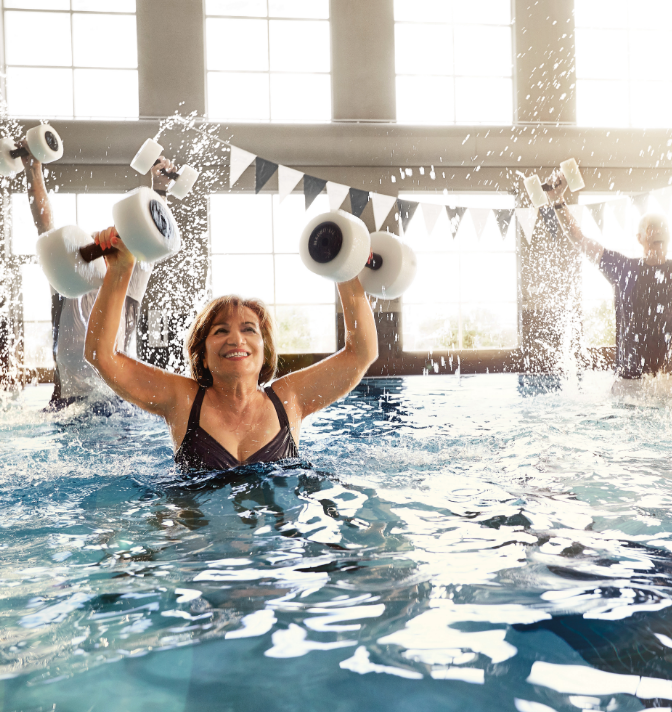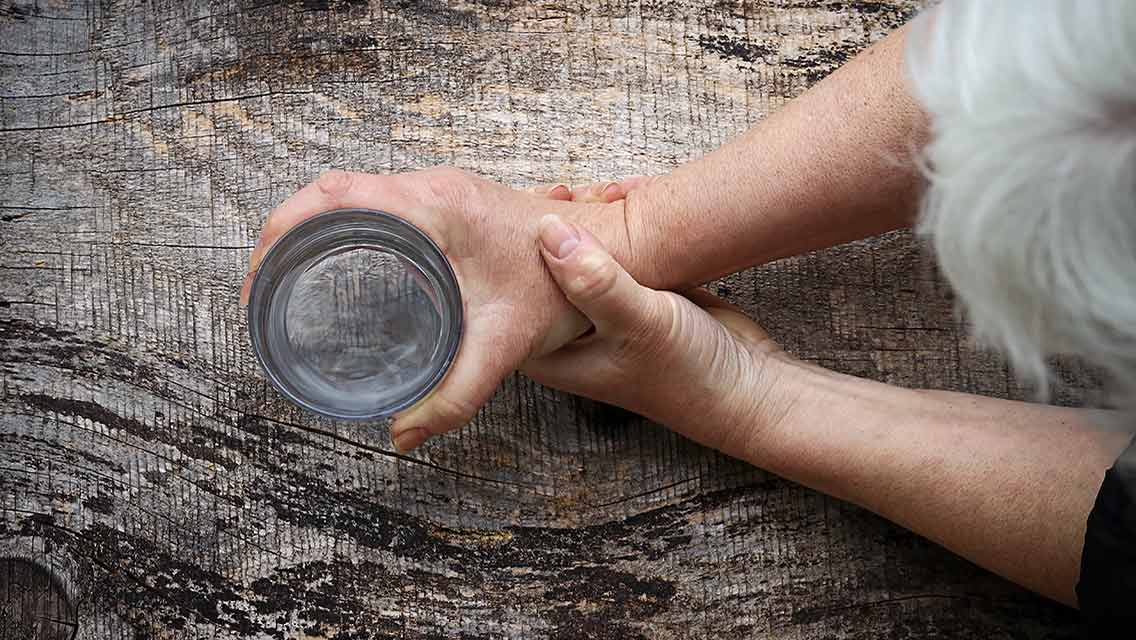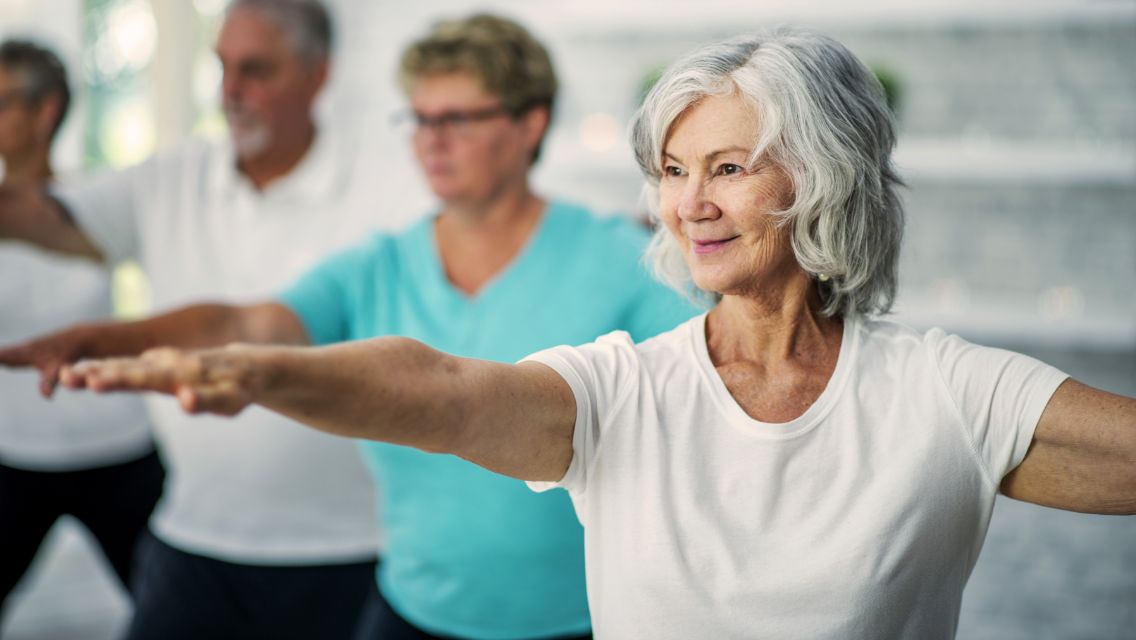Nearly 1 million people in the United States are living with Parkinson’s disease, making it the second-most-common neurodegenerative disorder, according to The Parkinson’s Foundation. This condition of the nervous system involves tremors, muscle rigidity, and slower movements. Symptoms can start slowly and get worse over time. Age is a key risk factor, with most people diagnosed at age 65 or older. And while there is currently no cure for the disease, there is hope in slowing the progression of its symptoms.
“Parkinson’s may be a chronic and progressive disease, but daily exercise increases neuroplasticity,” says Tara Sayer, RN, BSN, MSCN, CPT, CES, Dynamic Personal Trainer at Life Time in Des Moines, Iowa. “Consistently exercising can help your brain ‘rewire’ itself and strengthen the communication between neurons to prevent and protect your body from Parkinson’s symptoms for a longer period of time.”
Because exercise is so important in ensuring a higher quality of life for those with Parkinson’s, we spoke with two experts for advice on how to safely reap the benefits.
Meet Our Experts
Tara Sayer, RN, BSN, MSCN, CPT, CES
Sayer is certified in advanced Parkinson’s disease specific training. She works with individuals who have Parkinson’s disease, multiple sclerosis, paraplegia, and other neurological disorders.
Robert Murphy, M.S., CPT, PES, MMACS
Murphy is an ARORA-certified Dynamic Personal Trainer and group training coach at Life Time in Novi, Mich. He has worked with hundreds of individuals with Parkinson’s disease at Life Time and as a certified coach with the Rock Steady Boxing organization.
Before You Start a Workout Program
If you’re diagnosed with Parkinson’s or are experiencing symptoms, it’s important to note that no two cases are the same.
“There’s a popular saying for Parkinson’s coaches: ‘If you’ve met one person with Parkinson’s — you’ve met one person with Parkinson’s,’” says Murphy. “Essentially, no two people will display or experience symptoms the same.”
“Parkinson’s is often referred to as a ‘snowflake disease,’” Sayer adds. “Each person presents uniquely and differs in past medical history, previous workout experience, symptomology, psychology, and ability. The exercises that can benefit a person also depend on their day and how they’re feeling at that moment.”
Before you begin a workout program, consult with your physician or neurologist to discuss your treatment options and recommendations for exercise. “A comprehensive assessment of your past medical history and risks is vital to ensuring safety for anyone with Parkinson’s disease,” says Sayer. “If you’re working with a personal trainer, they’ll need this information as well as an emergency contact for you.”
5 Tips for Exercising with Parkinson’s Disease
1. Create a safe workout environment.
A safe training space for those with Parkinson’s is essential. “All bags and equipment must be placed on the perimeter of your training space,” Murphy advises. “Be sure to have a chair or mat nearby in case you need to sit or take a break.”
Clothing choices are also important, according to Murphy. “In my opinion, one of the most important pieces of equipment for a Parkinson’s athlete is their shoes,” he says. “Investing in a pair of well-fitting, quality training shoes — think cross-training, not running — will go a long way. I also recommend working out in loose, comfortable athletic gear and having layers for when you heat up or cool down throughout your workout.”
2. Practice balance daily.
One of the most important skills to work on when battling Parkinson’s disease is balance. That’s why Murphy recommends practicing basic balance exercises at least once per day.
“I encourage the people I work with to do balance work for 10 to 12 minutes every day,” says Murphy. “It’s not a lot of time to invest for a lot of benefits.”
Sayer adds that balance work doesn’t have to be complicated. “You don’t need fancy equipment. Balance exercises can be completed at home with minimal or no equipment,” she notes. “Simple, consistent movements like standing on one leg while you brush your teeth or wash the dishes can improve balance significantly. Standing on a pillow, Airex balance pad, or even just while closing your eyes can all be little ways to improve your balance.”
3. Try something new.
There are many different types of exercises that can help slow the progression of Parkinson’s, including the following:
- Water workouts can help with circulation while creating sustained resistance, which allows you to increase intensity without impact. ARORA Aqua classes are a safe option for enjoying time in the water while also working on coordination, strength, cardio, and mobility.
- Tai chi brings together the body and the mind, which is why it is is generally recognized as a highly effective modality to slow Parkinson’s symptoms.
- Noncontact boxing involves gross motor skills and cognitive exercises, along with balance and core strength work. Studies show that this kind of intense movement may be neuroprotective.
- Dance classes can help you work on balance, coordination, and cognition — while offering the benefits of community and fun.
- Yoga can help reduce tremors and other motor symptoms by encouraging functional mobility and stability.
“If you find one of these modalities that you enjoy, keep at it!” Sayer advises. “You’re more likely to continue to exercise if you’re doing something you enjoy and look forward to. That is key in any workout program.”
4. Stretch every day.
Flexibility and mobility are crucial to being able to move independently. In combination with exercise, stretching can improve joint and muscular capabilities for those with Parkinson’s.
“Given that many folks battling Parkinson’s will endure stiffness, rigidity, and skeletal muscle discomfort, a daily routine that includes flexibility work is highly recommended,” says Murphy. “Just like balance work, stretching is an important daily habit for individuals with Parkinson’s. Yoga, barre, and stretch workouts are all fantastic modalities to reduce stiffness, move better, and live well.”
5. Lean on your community.
Fighting Parkinson’s is never something you have to do alone. “Look to your personal circle of people who care about you and are ready to fight with you,” says Sayer. “Life Time is also a large community of people who can join your circle. Working with a personal trainer can help you find a workout program that’s right for you, whether that’s one-on-one dynamic personal training or in a group or a class. There are passionate fitness professionals who will not only meet you where you’re at, no matter where you are in your journey, but also be there as part of your support system.”
Sayer also suggests bringing your loved ones to work out with you. “Feel free to bring your spouse or care-partners,” she adds. “I always encourage their presence and love to see my clients working out with people they love!”
Nutrition and Parkinson’s Disease
Nutrition is a crucial factor in maintaining a healthy brain and nervous system, according to Sayer. Nutritious foods also help fuel your workouts and improve your muscle function. She offers the following tips to complement your workout routine.
Eat your omega-3s.
A diet high in omega-3s can be neuroprotective. Research shows its antioxidant properties can protect against free radical damage, which increases risk for diseases. Together with phospholipids, omega-3s also form the basic structure of all cell membranes, and healthy cell membranes are important for brain function. Try seed sources including flaxseed oil or ground flaxseed, chia seeds, hemp seeds, and pumpkin seeds, or other options such as wild-caught salmon, herring, mackerel, and trout. A high-quality fish oil supplement is also a reliable and consistent source.
Prioritize fiber.
High-fiber foods help improve bowel health and nourish the lining of the gut, which leads to better nutrient absorption. The gut and brain are intricately related; to support a healthy brain, you need to support a healthy gut. Most individuals benefit from an intake of at least 30 to 35 grams of fiber per day. Wheat bran, psyllium husk, pears, beans, lentils, broccoli, berries, avocados, apples, nuts, chia seeds, ground flaxseeds, and whole grains like oats can all be helpful sources of fiber. A diet high in insoluble fiber can also help reduce or eliminate constipation, a symptom people with Parkinson’s disease may experience.
Go for anti-inflammatory foods and avoid refinded sugar.
Anti-inflammatory foods and herbs can help prevent cellular stress for a healthier nervous system. Aim for more berries, fatty fish, green leafy vegetables, mushrooms (like lion’s mane, chaga, reishi, and cordycepts), avocados, extra-virgin olive oil, cabbage, onions, garlic, cocoa, and elderberries. Sayer also recommends avoiding sugars and refined carbohydrates such as white flours in bread or pasta, crackers, and other processed products.
Supplement when needed.
CoQ10, creatine, N-acetylcysteine, vitamin D3, and vitamin B6 are all nutrients that can be especially helpful forindividuals with Parkinson’s disease, assisting with energy levels, workout recovery, immunity, and more. Botanicals like Mucuna pruriens (an Ayurvedic herb) and turmeric also have anti-inflammatory properties. Check with a healthcare professional before taking any new supplements.
Consider a moderate dose of caffeine.
Studies show that a moderate amount of caffeine can help with movement symptoms for those with Parkinson’s disease. A cup of green tea is an option for consuming a small amount of caffeine with added anti-inflammatory benefits.
Sayer notes that it’s important to consult with your healthcare team when it comes to nutrition. “Be sure to discuss your medications and timing of eating with a nutrition professional,” she says. “Certain types of eating patterns can help with insulin transport and dopamine synthesis. It’s also important to know how your food may interact with your medications.”





